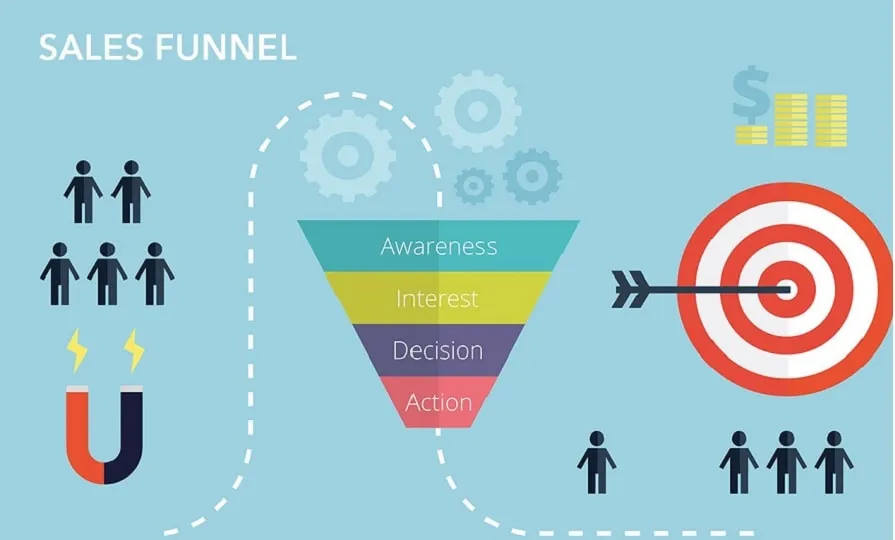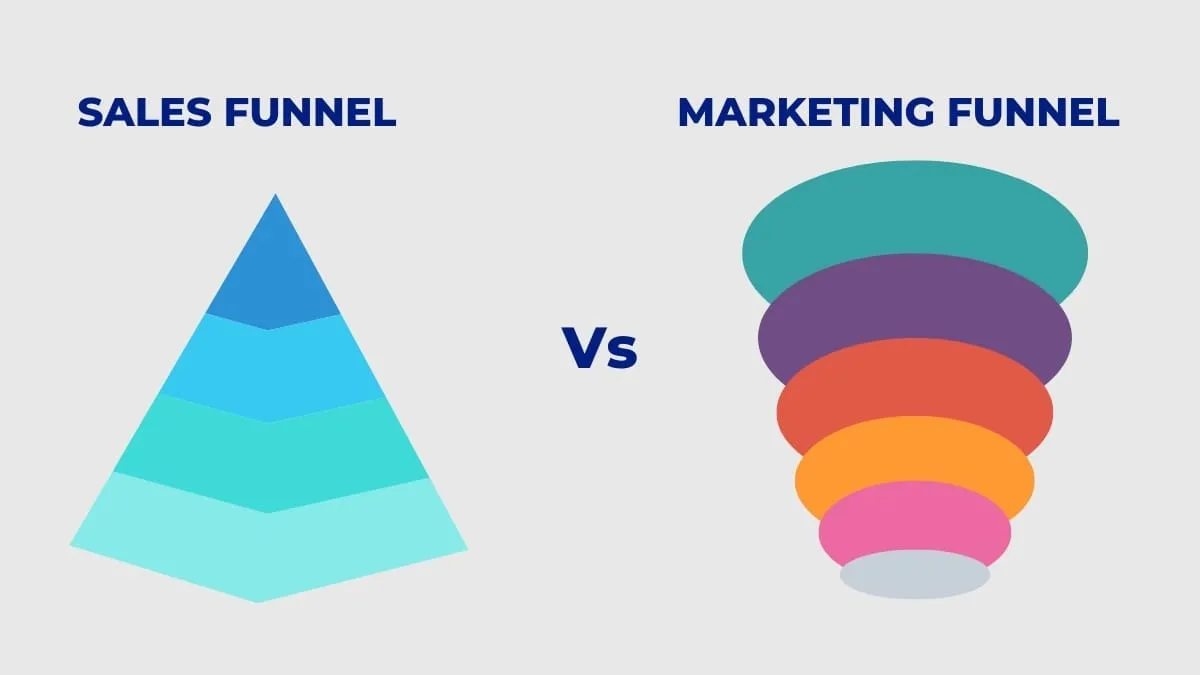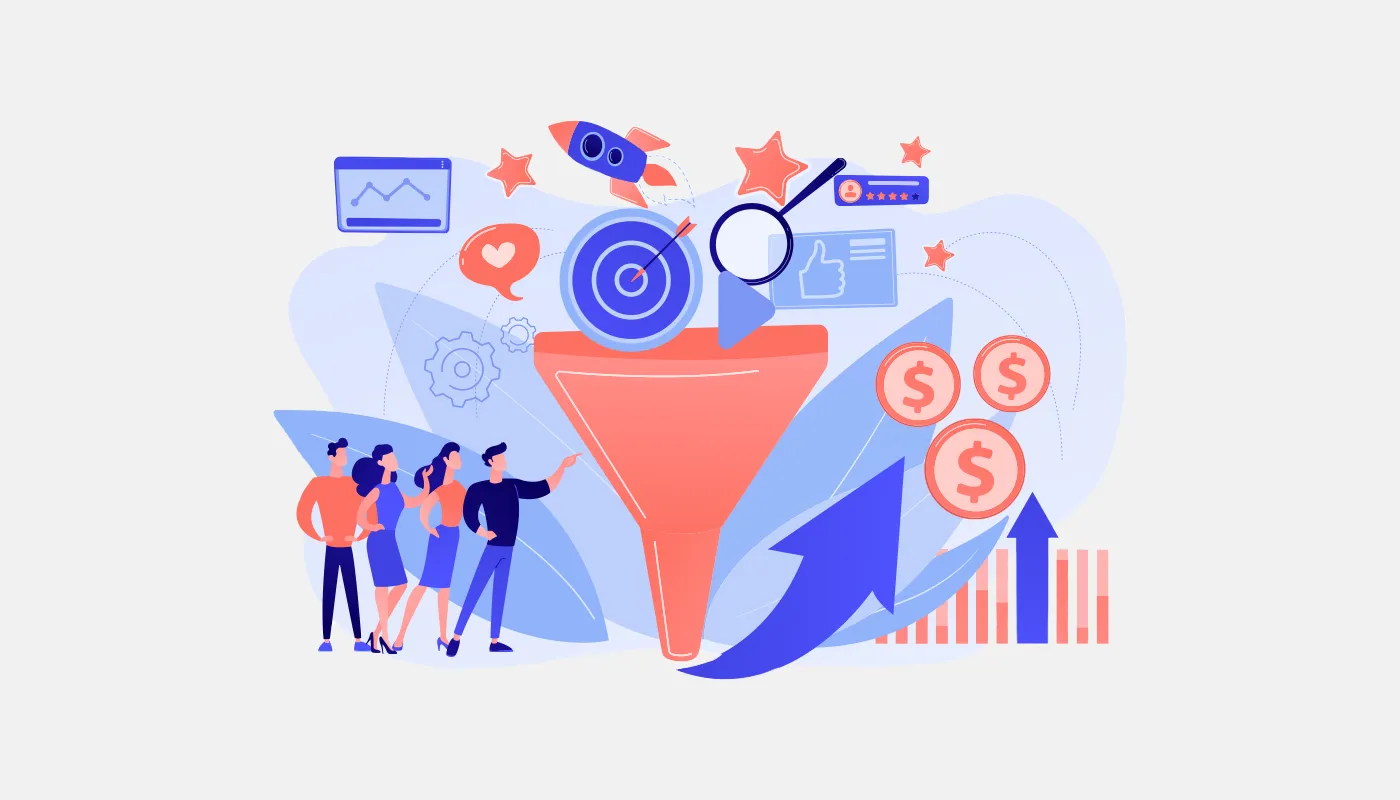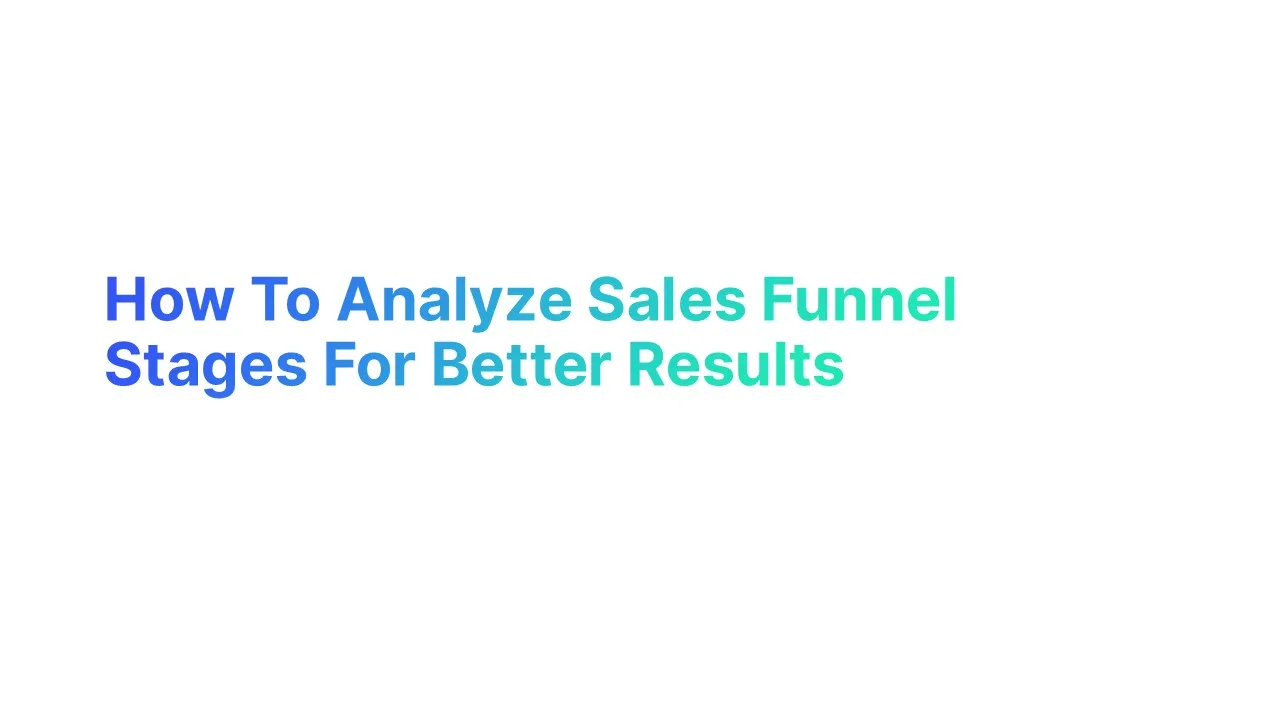What is a Sales Funnel?

A sales funnel is a visual representation of the journey potential customers take from first discovering your product to making a purchase. It starts wide at the top of the funnel with many potential customers and narrows down as only a few make it to the final stage.
Understanding sales funnel stages helps businesses manage and optimize this journey. Implementing a clear sales funnel model helps in visualizing the stages potential customers go through.
Why is Sales Funnel Important in a Sales Process?
A sales funnel is crucial because it helps businesses understand and predict customer behavior. Here are the key reasons why a sales funnel is important:
1. Organized Sales Process
- A sales funnel provides a clear structure for managing leads.
- It helps the sales team stay organized and focused on guiding potential customers through each stage of the funnel.
- This organization is critical for ensuring that no potential customer is overlooked.
2. Targeted Marketing Efforts
- By understanding which stage a potential customer is in, businesses can create targeted marketing campaigns.
- For instance, social media posts and marketing funnels can be tailored to attract prospects in the awareness stage.
- This targeting increases the chances of converting potential customers into paying customers.
3. Improved Customer Interactions
- A well-defined sales funnel allows sales reps to have more meaningful interactions with potential customers.
- They can provide relevant information and address specific needs at each stage, from initial interest to final purchase.
- This personalized approach enhances the overall customer journey.
4. Efficiency in Resource Allocation
- Sales funnels help businesses allocate their resources more efficiently.
- By identifying where most potential customers drop off, companies can focus on improving those stages.
5. Performance Tracking
- Tracking the performance of each stage in the sales funnel is crucial for continuous improvement.
- Businesses can monitor key metrics such as conversion rates and sales pipeline progression.
- Using tools like Google Analytics, they can gain insights into what works and what needs adjustment.
6. Enhanced Customer Retention
- A successful sales funnel not only converts prospects into paying customers but also helps in retaining them.
- By providing a smooth and satisfying customer journey, businesses can foster loyalty among existing customers.
According to Bain & Company, increasing customer retention rates by 5% can increase profits by 25% to 95%.
7. Predictable Revenue Growth
- A well-managed sales funnel allows businesses to predict future sales more accurately.
- By analyzing the funnel stages, companies can estimate how many potential customers will likely become paying customers.
- This predictability helps in planning and scaling the business effectively.
5 Sales Funnel Stages

1. Awareness Stage
The awareness stage is the first step in the sales funnel process. Here, potential customers learn about your product or service for the first time. This stage is all about generating interest and attracting as many people as possible.
Generating Interest:
- Use social media posts, blog articles, and marketing campaigns to reach a broad audience.
- For example, a company selling eco-friendly products might write blog posts about the benefits of using sustainable materials.
Engaging Content:
- Create engaging content that answers common questions.
- For instance, you could make videos explaining how your product solves a problem.
- According to HubSpot, 81% of shoppers conduct online research before buying, so having a strong online presence is key.
2. Interest Stage
In the interest stage, potential customers start to show interest in your product. They might visit your website or follow your social media pages. Your goal here is to keep them engaged and provide more information.
Informative Content:
- Share detailed content like how-to guides, whitepapers, and case studies.
- Data from DemandGen Report states that 47% of buyers view 3-5 pieces of content before engaging with a sales rep.
Lead Magnets:
- Offer free resources like a free sales funnel template to capture contact details.
- This way, you can follow up with potential customers and provide them with more information.
3. Consideration Stage
In the consideration stage, potential customers are evaluating your product against others. They are looking for the best solution to their problem.
Product Comparisons:
- Provide comparisons of your product with competitors.
- Highlight the unique features and benefits of your product.
Customer Reviews:
- Share testimonials and reviews from existing customers.
- According to Salesforce, 79% of business buyers say it’s critical to interact with knowledgeable sales reps who add value to their business.
4. Intent Stage
In the intent stage, potential customers are ready to buy. They may add items to their cart or sign up for a trial. This stage requires careful handling to ensure the sale goes through.
Personal Follow-ups:
- Sales reps should follow up with potential buyers, answer any questions, and address concerns.
- Personalized emails or phone calls can make a big difference.
Special Offers:
- Provide incentives like discounts or free trials to encourage immediate purchase.
5. Purchase Stage
Finally, the potential customer becomes a paying customer. This stage of sales funnel work involves making the purchase process smooth and ensuring customer satisfaction.
Easy Checkout Process:
- Ensure your checkout process is user-friendly.
- Complicated steps can lead to abandoned carts.
Post-Purchase Support:
- Offer excellent customer support to help with any issues.
- Follow up to ensure customer satisfaction and encourage repeat business.
Sales Funnel Vs Marketing Funnel

What is a Sales Funnel?
A sales funnel represents the stages a potential customer goes through to become a paying customer. It focuses on the sales process, from the first interaction with customer funnel, to the final purchase.
Stages of a Sales Funnel:
- Awareness Stage: Potential customers learn about your product or service. This is where they first hear about what you offer.
- Interest Stage: They start to show interest and seek more information. They might visit your website or follow your social media posts.
- Consideration Stage: They consider buying your product. They compare it with other options and read reviews.
- Intent Stage: They decide they want to buy. They might add items to their cart or sign up for a trial.
- Purchase Stage: They make the purchase and become paying customers.
Example: Imagine you are selling a new type of eco-friendly water bottle.
A potential customer sees your ad on social media (awareness), clicks on the ad to learn more (interest), reads reviews and compares your bottle to others (consideration), decides to buy and adds it to their cart (intent), and finally purchases it (purchase).
What is a Marketing Funnel?
A marketing funnel focuses on attracting and engaging potential customers. It covers the stages of building awareness and interest before they enter the sales or bottom of the funnel.
Stages of a Marketing Funnel
- Top of Funnel (TOFU): This stage is about creating awareness. Marketing campaigns, social media posts, and content marketing are used to attract a broad audience.
- Middle of Funnel (MOFU): Here, the focus is on generating interest and nurturing leads. This can involve email marketing, free resources like eBooks, and webinars.
- Bottom of Funnel (BOFU): This stage aims to convert leads into potential customers. It includes offering trials, product demos, and personalized marketing.
Example: For the eco-friendly water bottle, your marketing funnel might include running a Facebook ad campaign (TOFU), offering a free eBook on sustainable living to capture emails (MOFU), and sending personalized emails with a discount code (BOFU).
Differences Between Sales Funnel and Marketing Funnel
While both funnels aim to guide potential customers through their journey, they differ in focus and stages.
Focus:
- Sales Funnel: Focuses on converting potential customers into paying customers.
- Marketing Funnel: Focuses on attracting and engaging potential customers.
Stages:
- Sales Funnel: Includes stages like interest, consideration, intent, and purchase.
- Marketing Funnel: Includes stages like awareness, nurturing, and conversion.
Activities:
- Sales Funnel: Involves direct interactions with sales reps, product demos, and closing the deal.
- Marketing Funnel: Involves creating content, running marketing campaigns, and lead nurturing.
How To Analyze Performance of a Sales Team Throughout the Sales Funnel

1. Set Up Sales Funnel Tracking for Your Sales Team
Why is it important?
Setting up sales funnel tracking helps you monitor each stage of the sales process. It allows you to see where potential customers drop off and where they move forward. This insight is vital for making data-driven decisions and improving your sales strategy.
How to do it?
Define Your Sales Funnel Stages:
- Clearly define each stage of your sales funnel.
- For example, the stages can include awareness, interest, consideration, intent, and purchase.
Example: A company selling software might define stages as:
- Awareness (visiting the website)
- Interest (downloading a free trial)
- Consideration (attending a demo)
- Intent (adding the product to the cart)
- Purchase (completing the transaction)
Use CRM Tools:
- Utilize Customer Relationship Management (CRM) tools to track potential customers through each stage.
- Tools like Salesforce or HubSpot can help you keep track of interactions and progress.
Example: By using HubSpot, a sales rep can see when a potential customer downloads a free sales funnel template (interest stage) and follows up with an email offering a demo (consideration stage).
Assign Tasks to Sales Reps:
- Make sure your sales reps know their responsibilities at each stage.
- They should follow up with potential customers, provide information, and move them to the next stage.
2. Use Key Metrics to Track the Sales Process
Why is it important?
Using key metrics to track the sales process helps you measure the effectiveness of your sales team. It shows you where potential customers are dropping off and where they are converting. This data is crucial for making improvements and ensuring a successful sales funnel.
How to do it?
Monitor Conversion Rates:
- Track how many potential customers move from one stage to the next.
- This helps you identify weak points in your sales funnel.
Example: If you see a high drop-off rate between the interest and consideration stages, you might need to provide more engaging content or better follow-up from sales reps.
Analyze Sales Cycle Length:
- Measure how long it takes for potential customers to move through the sales funnel.
- Shorter cycles often indicate a more efficient sales process.
Example: If it takes too long for potential customers to reach the purchase stage. Consider streamlining your company's sales model and process to provide additional support to speed up the decision-making process.
Track Customer Interactions:
- Keep a record of all interactions between your sales team and potential customers.
- This includes emails, phone calls, and meetings.
Example: Use CRM tools to log each interaction. This helps you understand the customer journey and improve your approach.
Evaluate Sales Pipeline Performance:
- Regularly review your sales pipeline to ensure it's functioning smoothly.
- Look for any bottlenecks or areas that need improvement.
Example: If you notice that many potential customers are stuck in the intent stage, it might be time to offer special promotions or discounts to encourage them to complete the purchase.
3. Use a Free Sales Funnel Template to Simplify Tracking
Why is it important?
A free sales funnel template helps you organize and track potential customers easily. It provides a clear structure for each stage of the sales process, making it easier to see where improvements are needed. Using a template saves time and ensures consistency in tracking.
How to do it?
Download a Template:
- Find and download a free sales funnel template that suits your business needs.
- Many CRM tools offer customizable templates.
Example: HubSpot offers a free sales funnel template that you can customize according to your own sales funnel and process.
Customize the Stages:
- Adjust the template to fit the specific stages of your sales funnel.
- This could include stages like awareness, interest, consideration, intent, and purchase.
Example: For a company selling eco-friendly products, the stages might be:
- Awareness (website visit)
- Interest (newsletter sign-up)
- Consideration (product demo)
- Intent (adding product to cart)
- Purchase (completing the transaction)
Input Data Regularly:
- Have your sales reps input data into the template regularly.
- This keeps the information up-to-date and helps in accurate tracking.
Review and Analyze:
- Regularly review the data in the template to identify patterns.
- Look for stages where potential customers drop off and make necessary adjustments.
Example: If many potential customers are dropping off at the consideration stage, you might need to improve your product demos or provide more detailed information.
4. Align Sales Reps and Marketing Teams for Better Performance
Why is it important?
Aligning your sales reps and marketing team ensures that both teams work together towards a common goal to generate leads. This collaboration helps in generating high-quality leads and converting them into paying customers. It improves communication and makes the sales process more efficient.
How to do it?
Regular Meetings:
- Schedule regular meetings between sales reps and the marketing team to discuss goals, strategies, and progress.
Example: Hold weekly meetings to discuss the performance of recent marketing campaigns and their impact on the sales funnel stages.
Share Data:
- Ensure that both teams have access to the same data.
- Use CRM tools to share information about potential customers and their journey through the sales funnel.
Example: Marketing can share data on potential or prospective customers who engages with social media posts, and sales reps can follow up with personalized emails.
Set Common Goals:
- Establish common goals for both teams.
- This could include targets for lead generation, conversion rates, and customer retention.
Example: Both sales teams can aim to increase the number of paying customers by 20% in the next quarter.
Create Joint Strategies:
- Develop strategies that involve both sales and marketing efforts.
- This could include coordinated marketing campaigns and sales follow-ups.
Example: If the marketing team launches a new campaign for a product, the sales team can follow up with interested potential customers to offer demos or answer questions.
5. Optimize Customer Interactions at Each Sales Funnel Stage
Why is it important?
Optimizing customer interactions at each sales funnel stage is important because it enhances the customer journey. Positive interactions build trust and move potential customers closer to making a purchase. This ensures a higher conversion rate and a more successful sales process.
How to do it?
Personalized Communication:
- Tailor your communication to each stage of the sales funnel.
- This makes potential customers feel valued and understood.
Example: In the awareness stage, provide general information about your product. In the consideration stage, offer detailed comparisons and customer reviews.
Prompt Responses:
- Ensure your sales reps respond quickly to inquiries.
- Prompt responses show that you value potential customers and are ready to help.
Example: If a potential customer emails with questions about your product, reply within a few hours with detailed answers and additional resources.
Consistent Follow-ups:
- Follow up regularly to keep potential customers engaged.
- This helps prevent them from losing interest.
Example: After a potential customer downloads a free sales funnel template, follow up with an email offering a product demo.
Provide Value:
- Offer valuable content at each stage.
- This could include how-to guides, case studies, and testimonials.
Example: In the interest stage, send potential customers a how-to guide on using your product effectively.
6. Analyze the Customer Journey to Improve Sales Funnel Performance
Why is it important?
Analyzing the customer journey helps you identify where potential customers drop off and why. By understanding these points, you can make targeted improvements to your sales funnel stages, leading to higher conversion rates and better customer retention.
How to do it?
Map the Customer Journey:
- Create a detailed map of the customer journey, noting each interaction and touchpoint.
Example: Map out how potential customers first hear about your product, engage with your content, and finally make a purchase.
Collect Data:
- Use CRM tools to collect data on customer interactions.
- This includes tracking emails, calls, and meetings.
Example: Salesforce can help you track how many potential customers move from the interest stage to the consideration stage.
Identify Drop-off Points:
- Analyze the data to find stages where potential customers commonly drop off.
- Understanding these points helps you pinpoint areas for improvement.
Example: If many potential customers drop off at the consideration stage, you might need to provide more detailed product information or better follow-up.
Make Targeted Improvements:
- Use the insights gained from your analysis to make targeted improvements.
- This could involve refining your messaging, offering additional resources, or enhancing customer support.
Example: If drop-offs occur during the interest stage, enhance your social media posts and marketing campaigns to better engage potential customers.
7. Evaluate Sales Team Performance and Sales Funnel Efficiency
Why is it important?
Evaluating the performance of your sales team and the efficiency of your sales funnel helps you understand strengths and weaknesses of sales leads. This ensures that every stage of the sales funnel is optimized and your sales team is performing at its best.
How to do it?
Set Clear Goals: Establish clear, measurable goals for your sales team. This could include targets for the number of new leads, conversion rates, or sales volumes.
Example: Set a goal for each sales rep to convert at least 10 potential customers per month.
Track Key Metrics:
- Use key metrics to track performance.
- Important metrics include the number of leads generated, conversion rates, and the time taken to move potential customers through the sales funnel stages.
Example: Use a CRM tool like Salesforce to track how quickly potential customers move from the awareness stage to the purchase stage.
Regular Reviews:
- Conduct regular performance reviews with your sales team.
- Discuss achievements, identify areas for improvement, and adjust strategies as needed.
Example: Hold monthly meetings to review sales funnel performance and discuss strategies for improvement.
Provide Training:
- Offer regular training sessions to improve the skills of your sales reps.
- Training can focus on areas such as communication skills, product knowledge, and customer interaction techniques.
Example: Organize workshops on how to handle customer objections effectively.
8. Generate High-Quality Leads and Convert Prospects
Why is it important?
Generating high-quality leads and converting prospects is essential for the success of your sales funnel marketing tactics. High-quality leads are more likely to become paying customers, improving your conversion rates and increasing sales.
How to do it?
Identify Your Target Audience:
- Clearly define your target audience.
- Understand their needs, preferences, and pain points.
Example: If you are selling eco-friendly products, your target customers or audience might include environmentally conscious consumers.
Create Engaging Content:
- Produce content that attracts and engages your target audience.
- This could include blog posts, social media posts, and how-to guides.
Example: Write a blog post about the benefits of using eco-friendly products and share it on social media.
Use Lead Magnets:
- Offer lead magnets like free trials, eBooks, or templates to attract potential customers.
- Ensure these resources provide real value.
Example: Offer a free sales funnel template to potential customers who sign up for your newsletter.
Nurture Leads:
- Keep potential customers engaged by providing them with valuable content and regular updates.
- Use email marketing to stay in touch and move them through the sales funnel stages.
Example: Send a series of follow-up emails with tips on using your product effectively.
Personalize Interactions:
- Personalize your interactions with potential customers.
- Tailor your messages to address their specific needs and concerns.
Example: If a potential customer shows interest in a specific product, send them detailed information and customer reviews about that product.
Conclusion
Understanding and analyzing the sales funnel stages is crucial for any sales team. It helps track potential customers and improve the sales process. By optimizing customer interactions and evaluating performance, you can guide potential customers smoothly through the sales funnel.
Use tools and data to make informed decisions. This approach ensures a successful sales funnel that converts leads into paying customers. Each stage is important in the customer journey.





.jpg)

.jpg)
